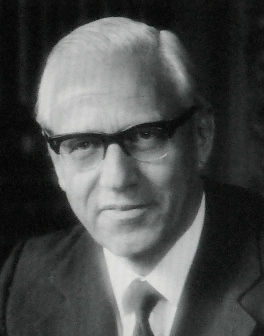Frederick Page facts for kids
Quick facts for kids
Sir
Frederick William Page
|
|
|---|---|
 |
|
| Born | 20 February 1917 |
| Died | 29 May 2005 (aged 88) |
| Education | St Catharine's College, Cambridge |
| Occupation | Engineer |
| Engineering career | |
| Discipline | Aerospace |
| Institutions | Royal Aeronautical Society |
| Projects | English Electric Lightning |
| Significant design | BAC TSR-2 |
| Awards | British Gold Medal for Aeronautics (1962), Gold Medal of the Royal Aeronautical Society (1974) |
Sir Frederick William Page (born February 20, 1917 – died May 29, 2005) was a brilliant English engineer. He designed and managed the creation of many important aircraft. He played a huge role in two famous British planes: the English Electric Lightning and the BAC TSR.2. For 45 years, until he retired in 1983, his work helped shape British aviation more than almost anyone else.
Contents
Early Life and Education
Frederick William Page was born in Wimbledon, London on February 20, 1917. His father was serving in the army and sadly died before Frederick was born. His mother, Ellen Sarah, raised him on her own.
Frederick was a very bright student. He won a scholarship to Rutlish Grammar School. Later, he earned another scholarship to attend St Catharine's College, Cambridge in 1935. He studied Mathematics and specialized in Aeronautics. He did so well that he earned top honors in both subjects.
Designing Aircraft
From a young age, Frederick Page wanted to design airplanes. He was excited by how quickly aircraft engineering was advancing. He saw it as a field where he could create new and amazing things.
Early Work at Hawker Aircraft
After finishing college in 1938, Page joined Hawker Aircraft. He worked under a famous designer named Sydney Camm. Page quickly became known for solving tough problems.
He helped fix issues with the Hawker Typhoon plane. For example, he designed special engine mounts to stop vibrations. He also created a unique seat for the pilot to make flights smoother.
Improving the Hawker Tempest
Page made big contributions to the Hawker Tempest fighter jet. He helped design its wings to make them faster. He used math to figure out the best shape for the wings. This helped the plane fly at very high speeds without problems.
He also invented a special "spring-tab" system for the Tempest's ailerons. Ailerons are parts on the wings that help a plane roll. His design made the Tempest much better at turning quickly in combat. This invention was so good that it was patented. It was even used later on the English Electric Canberra bomber.
Joining English Electric
By 1944, Page was one of Hawker's top aerodynamicists. He met Teddy Petter, who was putting together a team for English Electric. Petter wanted to design a new jet-powered plane to replace the de Havilland Mosquito. This new plane would become the famous English Electric Canberra.
Page joined Petter's team in 1945. He insisted on being in charge of many important areas. These included checking the plane's weight, testing its structure, and making sure all drawings were correct. He also wanted to give ideas for the plane's design.
The English Electric Canberra
The original idea for the Canberra had engines inside the plane's body. But Page believed that for the plane to be fast and carry enough fuel and weapons, the engines needed to be on the wings. His ideas were very important to the Canberra's final design.
Page's careful scientific analysis guided the plane's structure. When the Canberra first flew in May 1949, it was even lighter than expected! He also helped Petter build the design team. He famously said they needed a test pilot with real flying experience, not just engineers.
Leading the Lightning Project
In 1948, English Electric began designing a supersonic fighter jet. This project eventually became the amazing English Electric Lightning. Frederick Page was chosen to lead the design team.
The first design for the Lightning had wings swept back at 40 degrees. But to make it fly even faster (Mach 2, or twice the speed of sound), Page's team increased the wing sweep to 60 degrees. They also moved the ailerons to the wing tips.
By 1950, Frederick Page took over the full management of the design team. He worked incredibly hard to develop the Lightning while also finishing the Canberra. His team supported him through this busy time. He was formally appointed as the chief designer in February 1950.
Later Career and Honors
Frederick Page received many honors for his work. He was made a Commander of the Order of the British Empire (CBE) in 1961. He was knighted in 1979, becoming "Sir" Frederick Page. He also became a Fellow of the Royal Academy of Engineering and the Fellow of the Royal Society. These are very high honors for scientists and engineers.
British Aerospace
In 1977, several British aircraft companies merged to form British Aerospace. Sir Frederick Page became the Chairman and Chief Executive. He led the company until his retirement in 1982.
During his time at BAC and later British Aerospace, he oversaw the development of important military planes. These included the experimental BAC TSR-2, the multi-national Jaguar, and the Tornado IDS. Both the Jaguar and Tornado were very successful combat aircraft.
Personal Life
On July 6, 1940, Frederick Page married Kathleen Edith de Courcy. She was an artist and an ARP warden (a civilian who helped during air raids in World War II). They had four children: Gordon, Stephen, Alan, and Jennifer. Their son, Gordon, also became an aeronautical engineer.
After he retired, Sir Frederick Page stayed involved with several organizations. These included the Royal Academy of Engineering and the Royal Society.
Kathleen died in 1993. Sir Frederick Page passed away on May 29, 2005, in Mudeford, Dorset.
Images for kids


